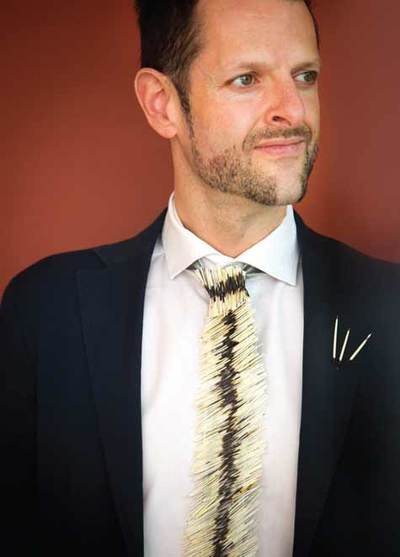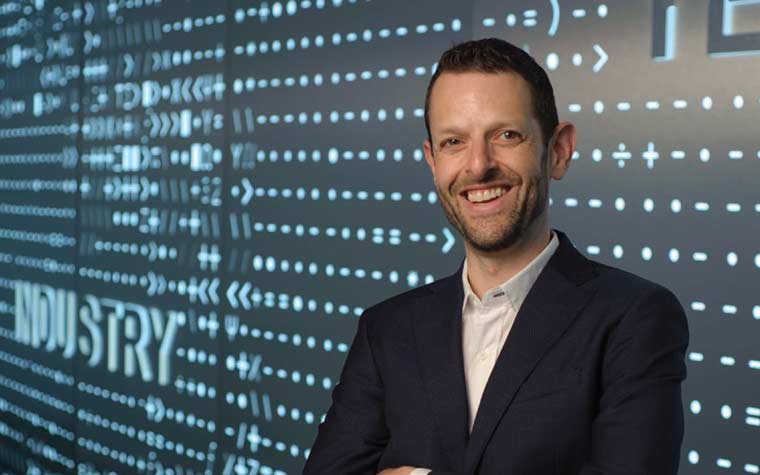When Bioengineer, Jeff Karp, was a kid growing up in the countryside near Peterborough, Ontario, he knew very little about engineering. He lived with his family in a house designed by famed Canadian architect Frank Gehry surrounded by farms and forests. The property included a creek where Karp would watch snapping turtles lay their eggs, not realizing these early encounters with nature would play a part in his success in the medical field.
Of course, Karp had no idea what his future held for him. “ I thought an engineer was the guy with the blue striped cap who drove the little train around the local zoo,” Karp laughs from his lab at Brigham and Women’s Hospital(BWH) in Boston, Massachusetts.
The Karp lab is where it all happens. Karp and his multidisciplinary team are at the forefront of regenerative medicine, focusing on stem cell therapeutics, drug delivery systems, and tissue adhesives- many of these approaches are inspired by nature. Known as a bioinspirationalist, Karp sees nature as a tool to help solve medical problems. “I look at nature with a purpose,” he says. “A lot of technologies we’ve developed have been influenced by nature.”
Karp’s career path was not smooth or direct. In fact, he says that he owes much of his successes to his failures having had to make significant adjustments to his future plans on several occasions.
After flunking a biology class in his first year at McGill University in Montreal, Quebec, Karp realized what he loves best is solving problems, so he turned to chemical engineering. Toward the end of his undergraduate studies, he thought it would make sense to apply to medical school- his father was a dentist and many of relatives were also healthcare professionals. He hoped to combine his medical degree with engineering but was not accepted into medical school .
It was a challenging time for Karp. “I’m the type of person that puts myself out there- I am fairly persistent, he says “If I fail, I always stand back up, and move forward with a slight rotation.”
A pivotal moment for Karp occurred when he overheard students chatting about growing new tissues and using engineering to develop new ways of delivering drugs. Karp realized he didn’t need to go to medical school to develop new therapies. “It was so obvious that biomedical engineering was a perfect match for me,” he says. “I knew I should be doing what excites me the most and I should be doing that everyday that I can.”
With the support of his parents, Karp stayed an extra year at McGill, to take some biomedical and bioengineering courses. Karp went on to earn his PhD in Chemical and Biomedical Engineering at University of Toronto (U of T).
Toward the end of Karp’s PhD degree at U of T, he began to eye the laboratory of Robert S. Langer, an award-winning, chemical engineer and the professor at the David. H. Koch Institute Professor at MIT in Cambridge. Karp knew he had to get Langer’s attention to distinguish himself from the thousands of applicants in line for a fellowship- coincidentally Langer’s was the only lab to which he applied. He sent Langer an ambitious email with the subject line, “A post doc candidate with BIG ideas” and wrote about how he wanted to solve medical problems- today, Karp jokes about not knowing exactly what his solutions were. Langer did get back to Karp but explained that he didn’t have the funds to pay him.
Not letting this minor hiccup stop his plans, Karp offered to secure his own funding, a proposal to which Langer agreed. Karp then applied to a Canadian fellowship program from the Natural Sciences and Engineering Research Council of Canada (NSERC)and received funding by the time he graduated with his PhD in 2004.
Working in Langer’s lab completely changed Karp’s trajectory. Langer remains a constant in Karp’s life both as a mentor and a colleague. They have co-founded several companies together, all of which have separate teams using different technologies.
The inspiration behind the creation of one of Karp’s company’s, Gecko Biomedical, that currently develops “ bio-mechanical technologies to boost the human body’s self-healing, ” came about late one evening at MIT during his fellowship. Karp was walking around the lab and noticed a science journal open on a colleague’s desk with a picture of Spiderman. Thinking it was odd, he took a closer look. The authors of the journal article had looked at geckos- small lizards that have nanostructures on the surface of their toes- and created a type of adhesive tape.
“To me this was really fascinating and exciting, because I had never looked at research through the lens of bioinspiration.” Karp says.

At 41 years old, Karp is considered one of the world’s leading innovators of bio-inspired medical technologies; he has been recognized by the Boston Business Journal as a Champion in Healthcare Innovation, and by MIT Technology Review magazine as being one of the top innovators in the world. (Photo courtesy of Jeff Karp.)
He immediately got to work, and together with a colleague submitted a grant proposal to MIT to develop a gecko inspired tissue that could be used in medicine. “Receiving over a million dollars in funding allowed me to pursue this bio-inspired path,” he remarks.
The first product, under Gecko Biomedical is now being tested on humans and is scheduled to be on the by market early 2018
By looking at examples of nature Karp is developing projects that focus on tissue regeneration. “If sharks can regrow their teeth, and lizards’ tails regenerate throughout their lifetime, why have humans been left out of this capacity to regenerate tissues?” Karp asks. “ He explains the human race does have its own regenerative capabilities, describing how the lining of one’s intestines completely regenerate every four to five days.
Karp co-founded Gecko Biomedical, Skintifique, Frequency Therapeutics and Alivio Therapeutics- companies that were created based on some of Karp’s groundbreaking technological discoveries. There are four products currently on the market
The Karp lab works simultaneously on approximately 25 different projects, ranging from a worm-inspired glue that mends hearts to making safer button cell batteries.
Whether Karp is collaborating with his team or addressing a group of dentistry and pharmaceutical students at their convocation, he is articulate yet extremely approachable.
He actively mentors those who work in his lab, helping advance the career of others. “For me, a mentor is somebody who sees your potential and treats you as if you’re already at that potential- they pull out the best in you,” he says.
At 41 years old, Karp is considered one of the world’s leading innovators of bioinspired medical technologies; he has been recognized by the Boston Business Journal as a Champion in Healthcare Innovation, by MIT’s Technology Review Magazine as being one of the top innovators in the world. He is also an associate professor at Brigham and Women’s Hospital, Harvard Medical School, part of the principal faculty at the Harvard Stem Cell Institute and an affiliate faculty member at the Broad Institute and the Harvard-MIT Division of Health Sciences and Technology. He was elected to the American Institute for Medical and Biological Engineering’s College of Fellows and as a Kavli Fellow.
At a TEDMED talk he gave, Karp casually strolled onstage dressed in jeans and a black Spiderman t-shirt demonstrating to the audience his ability to make the most complex ideas understandable, taking into account the complexities of each situation. He ended his talk with these impactful words, “It all comes back to Spiderman, that’s the ultimate example of stealing from nature,” he said. “And I recall an important message that Spidey’s alter ego, Peter Parker, learned from his beloved uncle Ben: ‘Peter, you must never forget that with great power comes great responsibility.’ I believe that we are all empowered by our ease of access to state-of- the-art tools and technologies, and by our ability to look at nature and leverage its secrets. But it’s up to us to learn the rules, to maximize our impact in a responsible way, and to do all that we can to make the world a better place.”
> This article by Rena Godfrey appeared in the Summer 2017 issue of Lifestyles Magazine.
